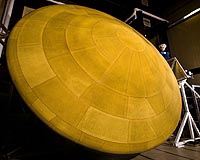 |
London, UK (SPX) Jun 30, 2009 New research led by a UK scientist indicates that Mars had significantly warmer weather in its recent past than previously thought. The research, funded by the UK's Science and Technology Facilities Council (STFC) and published in Earth and Planetary Science Letters, is good news in our quest for life on Mars, as the shorter the time period since the last warm weather on the planet, the better the chance that any organisms that may have lived in warmer times are still alive under the planet's surface. Dr. Matthew Balme, from The Open University, made the new discovery by studying detailed images of equatorial landforms that formed by melting of ice-rich soils. His work indicates that the Martian surface experienced "freeze thaw" cycles as recently as 2 million years ago, and that Mars has not been locked in permafrost conditions for billions of years as had been previously thought. The high resolution images, which show a variety of interesting landforms, were taken with NASA's HiRISE (High Resolution Imaging science Experiment) which is onboard the Mars Reconnaissance Orbiter (MRO) mission. Dr. Matthew Balme said, "The features of this terrain were previously interpreted to be the result of volcanic processes. The amazingly detailed images from HiRISE show that the features are instead caused by the expansion and contraction of ice, and by thawing of ice-rich ground. This all suggests a very different climate to what we see today ." All of the landforms observed are in an outflow channel, thought to have been active as recently as 2 million to 8 million years ago. Since the landforms exist within, and cut across, the pre-existing features of the channel, this suggests that they too were created within this timeframe. The pictures show polygonally patterned surfaces, branched channels, blocky debris and mound/cone structures. All of these features are similar to landforms on Earth typical of areas where permafrost terrain is melting. Dr. Balme said, "These observations demonstrate not only that there was ice near the Martian equator in the last few million years, but also that the ice melted to form liquid water and then refroze. And this probably happened for many cycles. Given that liquid water seems to be essential for life, these kinds of environments could be a great place to look for evidence of past life on Mars." Professor Keith Mason, CEO of the Science and Technology Facilities Council (STFC), said, "This new research has revealed more about Mars and provided fascinating evidence of geological process similar to Earth. The history of our neighboring planet, and the question of whether it has ever sustained life, has long fascinated man. Understanding current processes on the surface of Mars and the past and present role of climate improves our knowledge of the planet's history and thus the chances of one day detecting evidence for past or present life. UK scientists are involved in a number of different Mars studies, which are helping to paint a full picture of this mysterious planet." Share This Article With Planet Earth
Related Links UK Science and Technology Facilities Council (STFC) Mars News and Information at MarsDaily.com Lunar Dreams and more
 LockMart Completes Mars Science Laboratory Heatshield
LockMart Completes Mars Science Laboratory HeatshieldParis, France (SPX) Jun 18, 2009 Lockheed Martin has completed production and testing of the heatshield for NASA's Mars Science Laboratory (MSL). The heatshield is half of the large and sophisticated two-part aeroshell that will encapsulate and protect the Curiosity rover during its deep space cruise to Mars, and from the intense heat and friction that will be generated as the system descends through the Martian atmosphere. ... read more |
|
| The content herein, unless otherwise known to be public domain, are Copyright 1995-2009 - SpaceDaily. AFP and UPI Wire Stories are copyright Agence France-Presse and United Press International. ESA Portal Reports are copyright European Space Agency. All NASA sourced material is public domain. Additional copyrights may apply in whole or part to other bona fide parties. Advertising does not imply endorsement,agreement or approval of any opinions, statements or information provided by SpaceDaily on any Web page published or hosted by SpaceDaily. Privacy Statement |